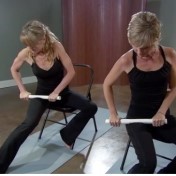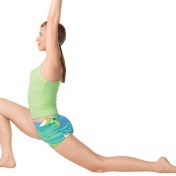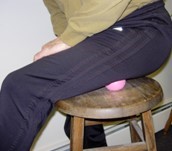What To Do For Tight Hamstrings
Author: Julie Donnelly, LMT –The Pain Relief Expert
Editor: Dr. Steve Chaney
You are about to begin your run, or maybe you have just finished running. Your hamstring feels really tight. Maybe it is even painful. It seems obvious that you need to stretch it, but that could be exactly the wrong thing to do!
You Need To Release Muscle Fiber Knots Before You Do Hamstring Stretches!
 Stretching can be dangerous if the muscle is shortened by spasms. A spasm (also called a muscle knot or trigger point) is like tying a knot in the center of the muscle. And while each spasm may only involve a few fibers; there can be multiple spasms throughout the muscle.
Stretching can be dangerous if the muscle is shortened by spasms. A spasm (also called a muscle knot or trigger point) is like tying a knot in the center of the muscle. And while each spasm may only involve a few fibers; there can be multiple spasms throughout the muscle.
Each spasm feels like a bump when you slide your fingers deeply down the length of the muscle. These spasms normally form over an extended period of time, often from repetitive strain on the muscle fibers.
Muscle Spasms Are At The Heart of the Stretching Misconception
It is important that you think of a spasm as a knot in the muscle fibers in order to understand why it can hurt to stretch.
A muscle begins on a stationary bone, crosses over a joint, and then inserts into a moveable bone. When the muscle pulls on the moveable bone, the joint moves, however, if the muscle has a “knot” in it you can cause micro-tears to the fibers as you stretch.
As you stretch, knots within the muscle get tighter, this also causes the fibers on either side of the spasm to overstretch. Overstretching can cause fiber tears either along the length of the muscle or where the fibers attach to the bone. In most cases this can be avoided by simply applying pressure to the muscle to release the spasm before you stretch.
What Do Hamstrings Do?
Your hamstrings are responsible for bending your knee. Every time you take a step, sit down, or climb stairs, you contract your hamstrings.
The only time your hamstrings aren’t contracting is when you are standing up straight. This means they are frequently repetitively strained and contain multiple spasms along the muscle fibers. These tight muscles put a strain on the back of your knee and at the origination point (the bottom of your posterior pelvis).
What Causes Tight Hamstrings?
The hamstrings are a bit unique from other muscles because while they can certainly have spasms in the fibers from repetitive strain injuries, they are also overstretched because of two major muscles that rotate the pelvis down in the front.
The two muscles that cause tight muscles to be overstretched are the iliopsoas (a muscle on the front side of the lumbar vertebrae) and the quadriceps (front of the thigh).
As these muscles get tight, primarily from sitting, they cause the pelvis to rotate forward and down. As your pelvis rotates down in the front, it rotates up in the back.
Since your hamstrings originate on the bottom of the posterior pelvis, as it is moving up, the muscle fibers are already overstretched – so you don’t need to stretch them further. In fact, if you stretch them they could potentially tear.
What Should You Do Before Your Hamstring Stretches?
 It’s actually a 3-step process. The key is to release tension in the front of the body before you can safely stretch the hamstrings.
It’s actually a 3-step process. The key is to release tension in the front of the body before you can safely stretch the hamstrings.
First you need to release the tension in your quadriceps, this will take the tension off the front of the pelvis. You do this by rolling out your quadriceps muscles which releases trigger points (muscle spasms).
 Next, stretch your iliopsoas. A low lunge is a great way to stretch the iliopsoas. This causes the pelvis to rotate up in the front and down in the back. As that happens tension is removed from the hamstrings.
Next, stretch your iliopsoas. A low lunge is a great way to stretch the iliopsoas. This causes the pelvis to rotate up in the front and down in the back. As that happens tension is removed from the hamstrings.
 Now you can release the spasms in the hamstrings. You do this by sitting on a trigger point therapy ball, ironing out your hamstrings. Stay on specific points of pain; these are the knots in the muscle fibers you need to release. The direct pressure forces out the toxins, draws in blood and causes muscle fibers to lengthen.
Now you can release the spasms in the hamstrings. You do this by sitting on a trigger point therapy ball, ironing out your hamstrings. Stay on specific points of pain; these are the knots in the muscle fibers you need to release. The direct pressure forces out the toxins, draws in blood and causes muscle fibers to lengthen.
Releasing muscle knots in your quadriceps, stretching your iliopsoas and releasing muscle knots in your hamstrings MUST be done before you can safely perform your hamstring stretches.
Do yourself a big favor and take these short steps; you will notice a difference!
Wishing you well,
Julie Donnelly
These statements have not been evaluated by the Food and Drug Administration. This information is not intended to diagnose, treat, cure or prevent any disease.
About The Author
 Julie Donnelly is a Deep Muscle Massage Therapist with 20 years of experience specializing in the treatment of chronic joint pain and sports injuries. She has worked extensively with elite athletes and patients who have been unsuccessful at finding relief through the more conventional therapies.
Julie Donnelly is a Deep Muscle Massage Therapist with 20 years of experience specializing in the treatment of chronic joint pain and sports injuries. She has worked extensively with elite athletes and patients who have been unsuccessful at finding relief through the more conventional therapies.
She has been widely published, both on – and off – line, in magazines, newsletters, and newspapers around the country. She is also often chosen to speak at national conventions, medical schools, and health facilities nationwide.
